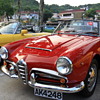Posted 11 years ago
 Chrisnp
Chrisnp
(310 items)
After the French adoption of the 1886 Lebel rifle I posted some time back, they needed a carbine that would fire their new smokeless ammo. They tried making a short version of the Lebel, but the results were unsatisfactory, and mounted troops had problems loading cartridges singly into the Lebel tube magazine, a problem their potential enemy, the Germans, didn’t face with their Mannlicher magazine system. Finally in 1890 the French settled on the Berthier, a design that would see action through both world wars, and even occasionally turn up in the hands of the Viet Cong, a legacy of French colonialism.
It’s interesting what the late 19th century French military establishment thought the requirements for a good carbine should be. This weapon uses a three round Mannlicher type en-block clip. That’s right, three rounds! The weapon has no safety, the idea being that troopers would not go around with a cartridge in the chamber, but would only chamber a round from the magazine when action was at hand and the sergeant gave the order. My guess is that the French believed that in the case of cavalry closing with the enemy, or the enemy overrunning the artillery, three rounds from the carbine would be all there was time for. In fairness, the previous firearm had been a single-shot, so in terms of firepower this was an improvement. WWI would show the insufficiency of three rounds, and later Berthiers would have a 5 round capacity.
My Berthier is the Model 1892 Artillery Musketoon, and differs from cavalry models primarily in its having a provision for a bayonet, which adds almost half the length of the firearm. Besides artillerymen, these firearms were also issued to engineers and other non-cavalry that needed a carbine length weapon. My Musketoon was manufactured at the St Etienne Arsenal in 1893, and at some point after 1932 it was refurbished and modified to fire the more powerful “Balle N” ammunition. This is indicated by an “N” stamped on the barrel and receiver where they meet. The leather sling is correct for this weapon.
Ammo: The Balle D rounds pictured are WWI issue in an original three-round Berthier clip. They have 198 grain, .323 caliber solid brass boat tailed spire point bullets that reached a velocity of 2300 fps. In 1932 the French created the much more powerful Balle N round for the Hotchkiss machinegun, using a 239 grain, .325 caliber cupro-nickel jacketed boat tail spitzer. Although this weapon has been modified to fire the Balle N, the recoil using that ammo in this little gun is unpleasant, to say the least. I will not be doing that again.
I use the same reloads for my Lebel and my Berthier; a 175 grain spitzer backed by 40 grains of IMR 4064. At 50 yards I got a nice 3 ½ inch group, dead center of the target using a six o’clock hold on the bullseye.
WARNING: Load data is provided for information only. Many vintage firearms are unsafe to shoot and I do not advise use of this load data for other firearms since I do not know the specific firearm that may be involved or its condition.
















About time you got back & crashed this garage sale. Great as usual. If you are running low on guns to poste, we will have to insist that you buy more.
One can never own too many guns! Short staffing at work means I'm having to push my posts to the end of the week, but I'm still resolved to do at least one post a week.
I/we, will hold you to that! Can't say I ever saw this one because of the stock shape at the mag. housing. Picked up a clean EAA .380 last nite with 50 rds.. I'll pick up $350-400 profit within a few days. Still love my .380 Browning although this one feels a little better in the hand. My best friend 4 yrs ago died & left the Browning so I will never let it go.
Thanks for the love fortapache, kerry10456, blunder, officialfuel, Manikin and geo26e.
Thanks for the love petey.